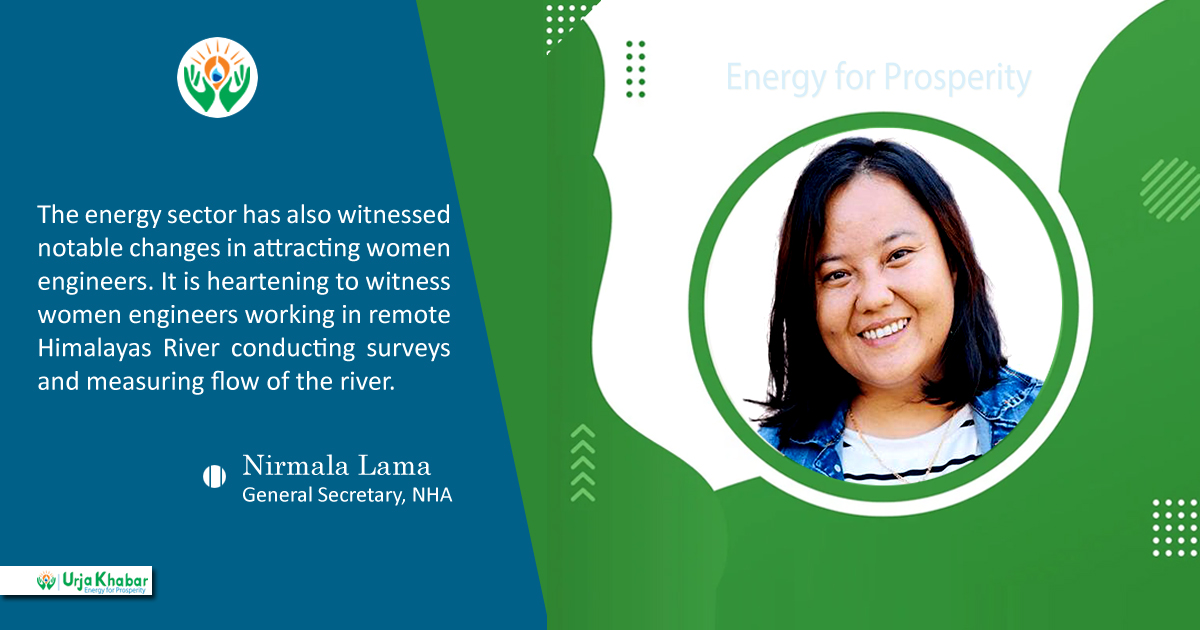
Introduction
In recent years, there has been a noticeable increase in the number of women moving towards technical fields, demonstrating steady progress in engineering disciplines. This inspiring trend is undoubtedly motivating the future generation of female engineers. The percentage of registered women engineers in Nepal Engineers Council is approximately 13 percent, however it’s important that the information has not been verified. Identifying the representation of women within the energy sector is crucial for their empowerment and meaningful inclusion in this vital industry. The energy industry has become an attractive field for women engineers, offering promising opportunities and a stimulating work environment.

This article presents the outcome of a comprehensive research study focused on the participation of female engineers in the energy sector. The research involved gathering data from approximately 20 reputable companies operating in the energy sector within the country. The collected data was meticulously processed, analyzed and synthesized to draw meaningful conclusion. The findings of this research shed light on the current state of gender representation and opportunities for women engineers in the energy industry, providing valuable insights for further discussions and initiatives to promote diversity and inclusivity in the field.
The Changing Landscape for Women in Engineering

Indeed, women in engineering, face both opportunities and challenges in their pursuit of a fulfilling and impact career. For many generations, women were often confined to roles within the household, and societal norms limited their opportunity to pursue careers in technical field. However, over the last few decades, this trend has been gradually changing as women ventured into various professions including engineering. Similarly, the energy sector has also witnessed notable changes in attracting women engineers. It is heartening to witness women engineers working in remote Himalayas River conducting survey and measuring flow of the river.
Diverse Roles, Diverse Expertise
Women engineers are found in various roles within the energy sector, from research and development to project management, environmental consulting, renewable energy, and more which is appreciable. Their expertise spans across different subfields, such as electrical, mechanical, chemical and environmental engineering. However, increasing this representation, in this energy sector is crucial for both gender inclusion and women's empowerment. Another important role for women in the energy sector lies in their potential to significantly contribute to the sustainable development. It is not only related to the adoption of green and clean energy practices; it includes future generation to fulfill their future energy need by using clean and green energy for their generation. In addition, a gender inclusive approach, which actively involves women, undoubtedly forms the milestone for achieving sustainable growth within the energy sector, with the ultimate goal for development of the nation.
Insights from data collection
Essentially, the count of female engineers employed within the energy sector for comparison with male counterparts, was obtained. A survey was conducted among the companies using a straightforward questionnaire to gather data, which included inquiries about the total number of female employees. A total of around twenty esteemed companies operating in the energy sector were included in the study. Among these, the total number of employees, specifically the female workforce, was calculated to provide precise data for female employees within the sector.
In total, over 1144 employees took part in the survey. Among them, 16.0% were women employed in the energy sector, spanning both technical and administrative roles. This data suggests a positive trend for women working beyond the household. However, to further improve these numbers, it's essential to empower men to contribute equally to domestic responsibilities. Focusing solely on empowering women to work outside without affording men equal opportunities at home could place an undue burden on women.
Out of the 1144 professionals employed in the energy sector, a substantial portion of 630 held engineering backgrounds. Among these engineers, a mere 91 were female, accounting for a modest 14 percent of the total. While this figure reflects notable progress in the sector towards gender inclusion, there is still room for improvement. Efforts to further promote diversity and equal opportunities for women in this field are paramount to achieving true gender balance.
Remarkably, women engineers are occupying key positions within companies, from Head of Civil Department to Assistant Manager. They have excelled in roles such as Project Engineer, Civil Engineer, Hydropower Engineer, and more, underscoring their competence and capability to thrive in high-ranking positions within the sector. Actively supporting their professional growth is essential not only for attracting but also for retaining these talented and dynamic energy engineers.
Furthermore, the data highlights a striking gender disparity within the hydropower site, indicating an alarmingly low representation of female engineers. Currently, a mere 6 percent of the workforce at the site comprises women in engineering roles. This glaring underrepresentation can be attributed, in part, to the formidable pressures that women face in managing both their professional responsibilities and the demands of their households. Many are confronted with the difficult decision of either uprooting their entire family to reside near the project site or relinquishing their careers altogether. Consequently, the numerical presence of women engineers at the site remains disproportionately low.
To address this imbalance, it is imperative to give due consideration to safety and the prevalence of harassment in the workplace. Creating an environment that is inclusive, respectful, and free from discrimination is essential in fostering an atmosphere where female engineers can thrive and contribute meaningfully to the hydropower project.
Summary
In conclusion, fostering an inclusive, respectful and discrimination-free environment is essential for female engineers to thrive and contribute meaningfully to the hydropower industry. By actively supporting their professional growth and ensuring equal opportunities both in the workplace and at home, we can further advance the empowerment and meaningful inclusion of women engineers in the vital energy sector of Nepal. This is not only a step towards a more balanced industry but also a cornerstone for the sustainable growth and development of the nation as a whole.
Mrs Lama is the General Secretary of Nepal Hydropower Association (NHA), also a Project Engineer of Hydro Lab Pvt. Ltd as well.

Mrs Lama is a General Secretary of Nepal Hydropower Association (NHA)